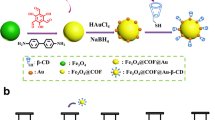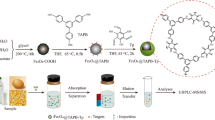Abstract
Recently, covalent organic frameworks have gained popularity in sample pretreatment. However, the application of covalent organic frameworks in the enrichment of hydrophilic compounds remains a challenge. Thus, a functionalized magnetic covalent organic framework equipped with amino groups was constructed using a bottom-up functionalization strategy. Considering the advantages of this novel adsorbent such as high porosity, large adsorption capacity, and hydrophilic surface, a sensitive magnetic solid-phase extraction coupled with high-performance liquid chromatography-tandem mass spectrometry method was established for the effective determination of neonicotinoids. This method exhibited good linearities with correlation coefficients ranging from 0.9983 to 0.9995, low detection limits in the range 0.003–0.009 ng g−1 and 0.001–0.013 ng mL−1, and limits of quantification in the range 0.010–0.031 ng g−1 and 0.004–0.044 ng mL−1. Furthermore, satisfactory repeatability with relative standard deviations ≤ 6.7% and spiked recoveries between 82.3 and 99.8% were obtained. This work not only provided a promising adsorbent for the sensitive determination of trace-level neonicotinoids but also represented a unique insight for effective enrichment of super hydrophilic hazards.
Graphical Abstract





Similar content being viewed by others
Data availability
The data and materials generated during and/or analyzed during the current study are available from the corresponding authors on reasonable request.
Abbreviations
- COFs:
-
Covalent organic frameworks
- POPs:
-
Porous organic polymers
- Fe3O4@TFPA-DAB-NH2 :
-
A functionalized magnetic covalent organic framework equipped with amino groups
- Fe3O4@TFPA-BD:
-
A magnetic covalent organic framework without amino groups
- HPLC:
-
High-performance liquid chromatography
- MS/MS:
-
Triple quadrupole tandem mass spectrometry
- UV:
-
Ultraviolet
- FLD:
-
Fluorescence
- DAD:
-
Diode array detection
- LLE:
-
Liquid-liquid extraction
- DSPE:
-
Dispersive solid-phase extraction
- MSPE:
-
Magnetic solid-phase extraction
- HPLC-MS/MS:
-
High-performance liquid chromatography-tandem mass spectrometry
- MSPE-HPLC-MS/MS:
-
High-performance liquid chromatography-tandem mass spectrometry based on magnetic solid-phase extraction
- NEOs:
-
Neonicotinoids
- FPNs:
-
Fipronils
- AFs:
-
Aflatoxins
- SUs:
-
Sulfonylurea insecticides
- ICL:
-
Imidacloprid
- CTN:
-
Clothianidin
- TCL:
-
Thiacloprid
- ACT:
-
Acetamiprid
- DAB:
-
3,3′-Diaminobenzidine
- TFPA:
-
Tris(4-formylphenyl) amine
- BD:
-
Benzidine
- FeCl3·6H2O:
-
Iron trichloride hexahydrate
- CH3COONa:
-
Sodium acetate anhydrous
- EG:
-
Ethylene glycol
- THF:
-
Tetrahydrofuran
- HAC:
-
Acetic acid
- FA:
-
Formic acid
- AC:
-
Acetone
- MA:
-
Methanol
- EA:
-
Ethanol
- ACN:
-
Acetonitrile
- SEM:
-
Scanning electron microscopy
- TEM:
-
Transmission electron microscope
- FTIR:
-
Fourier transform infrared
- XPS:
-
X-ray photoelectron spectroscopy
- BET:
-
Brunauer-Emmett-Teller
- BJH:
-
Barrett-Joyner-Halenda
- TGA:
-
Thermogravimetric analysis
- DTG:
-
Derivative thermogravimetry
- XRD:
-
X-ray diffraction
- R 2 :
-
Determination coefficient in adsorption isothermal and kinetic experiment
- r:
-
Correlation coefficient
- LODs:
-
Detection limits
- LOQs:
-
Limits of quantification
- RSDs:
-
Relative standard deviations
- ME:
-
Matrix effect
References
Tu H, Wei X, Pan Y, Tang Z, Yin R, Qin J, Li H, Li AJ, Qiu R (2023) Neonicotinoid insecticides and their metabolites: specimens tested, analytical methods and exposure characteristics in humans. Journal of Hazardous Materials 457. https://doi.org/10.1016/j.jhazmat.2023.131728
Wang H, Yang D, Fang H, Han M, Tang C, Wu J, Chen Y, Jiang Q (2020) Predictors, sources, and health risk of exposure to neonicotinoids in Chinese school children: a biomonitoring-based study. Environment International 143. https://doi.org/10.1016/j.envint.2020.105918
Rundlöf M, Andersson GKS, Bommarco R, Fries I, Hederström V, Herbertsson L, Jonsson O, Klatt BK, Pedersen TR, Yourstone J, Smith HG (2015) Seed coating with a neonicotinoid insecticide negatively affects wild bees. Nature 521(7550):77–80. https://doi.org/10.1038/nature14420
Pérez-Mayán L, Cobo-Golpe M, Ramil M, Cela R, Rodríguez I (2020) Evaluation of supercritical fluid chromatography accurate mass spectrometry for neonicotinoid compounds determination in wine samples. J Chromatography A 1620. https://doi.org/10.1016/j.chroma.2020.460963
Hsieh Y-H, Jung W-T, Lee H-L (2023) Novel vinylene-based covalent organic framework as a promising adsorbent for the rapid extraction of beta-agonists in meat samples. Anal ChimicaActa 1272. https://doi.org/10.1016/j.aca.2023.341492
Zhao W-H, Shi Y-P (2022) A porous boron nitride nanorods-based QuEChERS analysis method for detection of five neonicotinoid pesticide residues in goji berries. J Chromatography A 1670. https://doi.org/10.1016/j.chroma.2022.462968
Tu X, Chen W (2020) Miniaturized salting-out assisted liquid-liquid extraction combined with disposable pipette extraction for fast sample preparation of neonicotinoid pesticides in bee pollen. Molecules 25(23). https://doi.org/10.3390/molecules25235703
Guo L, Zhao B, Wang L, Wang Q, Yangjuan A, Hao L, Liu W, Wang Z, Wu Q, Wang C (2023) Design of hydroxyl-functionalized nanoporous organic polymer with tunable hydrophilic-hydrophobic surface for solid phase extraction of neonicotinoid insecticides. Talanta 258. https://doi.org/10.1016/j.talanta.2023.124441
Zhang Y, Zhang Q, Li S, Zhao Y, Chen D, Wu Y (2020) Simultaneous determination of neonicotinoids and fipronils in tea using a modified QuEChERS method and liquid chromatography-high resolution mass spectrometry. Food Chemistry 329. https://doi.org/10.1016/j.foodchem.2020.127159
Asgharinezhad AA, Ebrahimzadeh H (2020) A novel polymer coated magnetic porous carbon nanocomposite derived from a metal-organic framework for multi-target environmental pollutants preconcentration. J Chromatography A 1634. https://doi.org/10.1016/j.chroma.2020.461664
.Lu J, Wang R, Luan J, Li Y, He X, Chen L, Zhang Y (2020) A functionalized magnetic covalent organic framework for sensitive determination of trace neonicotinoid residues in vegetable samples. Journal of Chromatography A 1618. https://doi.org/10.1016/j.chroma.2020.460898
Mehdinia A, Einollahi S, Jabbari A (2016) Magnetite nanoparticles surface-modified with a zinc(II)-carboxylate Schiff base ligand as a sorbent for solid-phase extraction of organochlorine pesticides from seawater. Microchimica Acta 183(9):2615–2622. https://doi.org/10.1007/s00604-016-1894-4
Huang H, Li N, Chen Y, Shentu X, Yu X, Ye Z (2024) Synthesis of multiwalled carbon nanotubes/metal-organic framework composite for the determination of neonicotinoid pesticides in medicine and food homology products. Food Chemistry 434. https://doi.org/10.1016/j.foodchem.2023.137354
An Y, Wang J, Jiang S, Li M, Li S, Wang Q, Hao L, Wang C, Wang Z, Zhou J, Wu Q (2022) Synthesis of natural proanthocyanidin based novel magnetic nanoporous organic polymer as advanced sorbent for neonicotinoid insecticides. Food Chemistry 373. https://doi.org/10.1016/j.foodchem.2021.131572
Guo L, Tian M, Wang L, Zhou X, Wang Q, Hao L, Wu Q, Wang Z, Wang C (2023) Synthesis of hydroxyl-functional magnetic hypercrosslinked polymer as high efficiency adsorbent for sensitively detecting neonicotinoid residues in water and lettuce samples. Microchemical J 187. https://doi.org/10.1016/j.microc.2023.108412
Jiang S, Meng X, Xu M, Li M, Li S, Wang Q, Liu W, Hao L, Wang J, Wang C, Wang Z, Wu Q (2022) Green synthesis of novel magnetic porous organic polymer for magnetic solid phase extraction of neonicotinoids in lemon juice and honey samples. Food Chemistry 383. https://doi.org/10.1016/j.foodchem.2022.132599
Cao X, Hu Y, Yu H, Sun S, Xu D, Zhang Z, Cong S, She Y (2024) Detection of neonicotinoids in agricultural products using magnetic molecularly imprinted polymers-surface enhanced Raman spectroscopy. Talanta 266. https://doi.org/10.1016/j.talanta.2023.125000
Wang D, Liu Y, Xu Z, Ji Y, Si X, Lin T, Liu H, Liu Z (2022) Generic imprinted fiber array strategy for high-throughput and ultrasensitive simultaneous determination of multiple neonicotinoids. Food Chem 382. https://doi.org/10.1016/j.foodchem.2022.132407
Hao Q, Tao Y, Ding X, Yang Y, Feng J, Wang R-L, Chen X-M, Chen G-L, Li X, OuYang H, Hu X, Tian J, Han B-H, Zhu G, Wang W, Zhang F, Tan B, Li Z-T, Wang D, Wan L-J (2023) Porous organic polymers: a progress report in China. Sci China Chem. https://doi.org/10.1007/s11426-022-1475-x
Huang N, Wang P, Jiang D (2016) Covalent organic frameworks: a materials platform for structural and functional designs. Nature Reviews Materials 1(10). https://doi.org/10.1038/natrevmats.2016.68
Meng Z, Mirica KA (2021) Covalent organic frameworks as multifunctional materials for chemical detection. Chem Soc Rev 50(24):13498–13558. https://doi.org/10.1039/d1cs00600b
Torabi E, Mirzaei M, Bazargan M, Amiri A (2022) A critical review of covalent organic frameworks-based sorbents in extraction methods. Anal Chimica Acta 1224. https://doi.org/10.1016/j.aca.2022.340207
Li N, Du J, Wu D, Liu J, Li N, Sun Z, Li G, Wu Y (2018) Recent advances in facile synthesis and applications of covalent organic framework materials as superior adsorbents in sample pretreatment. TrAC Trends Anal Chem 108:154–166. https://doi.org/10.1016/j.trac.2018.08.025
Wang J, Feng J, Lian Y, Sun X, Wang M, Sun M (2023) Advances of the functionalized covalent organic frameworks for sample preparation in food field. Food Chemistry 405. https://doi.org/10.1016/j.foodchem.2022.134818
Iqbal R, Yasin, G, Hamza M, Ibraheem S, Ullah B, Saleem A, Ali S, Hussain S, Anh Nguyen T, Slimani Y, Pathak R (2021) State of the art two-dimensional covalent organic frameworks: prospects from rational design and reactions to applications for advanced energy storage technologies. Coordination Chem Rev 447. https://doi.org/10.1016/j.ccr.2021.214152
Wang S, Xu X, Yue Y, Yu K, Shui Q, Huang N, Chen H (2020) Semiconductive covalent organic frameworks: structural design, synthesis, and application. Small Structures 1(2). https://doi.org/10.1002/sstr.202000021
Wang S, Yuan N, Dai T, Chang Z, Liang Y, Liu X, Chen Q, Hu B, Wang N (2021) Surface post-functionalization of COFs by economical strategy via multiple-component one-pot tandem reactions and their application in adsorption of pesticides. Adv Compos Hybrid Mat 5(2):1439–1449. https://doi.org/10.1007/s42114-021-00241-0
Zhao Y, Feng C, Tian C, Li Z, Yang Y (2022) Enhanced adsorption selectivity of bisphenol analogues by tuning the functional groups of covalent organic frameworks (COFs). Separation and Purification Technology 297. https://doi.org/10.1016/j.seppur.2022.121489
Wang T, Xie H, Cao Y, Xu Q, Gan N (2022) Magnetic solid phase extraction coupled with high-performance liquid chromatography-diode array detection based on assembled magnetic covalent organic frameworks for selective extraction and detection of microcystins in aquatic foods. J Chromat A 1685. https://doi.org/10.1016/j.chroma.2022.463614
Li Y, Yang C-X, Yan X-P (2017) Controllable preparation of core–shell magnetic covalent-organic framework nanospheres for efficient adsorption and removal of bisphenols in aqueous solution. Chem Comm 53(16):2511–2514. https://doi.org/10.1039/c6cc10188g
Liu JL, Zong EM, Fu HY, Zheng SR, Xu ZY, Zhu DQ (2012) Adsorption of aromatic compounds on porous covalent triazine-based framework. J Coll Interface Sci 372:99–107. https://doi.org/10.1016/j.jcis.2012.01.011
Saini SS, Abdel-Rehim M (2020) Integrated extraction approach for trace analysis of aflatoxin B1 in domestic water tanks using HPLC. Separation Science Plus 3(5):167–174. https://doi.org/10.1002/sscp.202000013
Liu W, Wang J, Song S, Hao L, Liu J, An Y, Guo Y, Wu Q, Wang C, Wang Z (2022) Facile synthesis of uniform spherical covalent organic frameworks for determination of neonicotinoid insecticides. Food Chemistry 367. https://doi.org/10.1016/j.foodchem.2021.130653
Lv S-W, Liu J-M, Ma H, Wang Z-H, Li C-Y, Zhao N, Wang S (2019) Simultaneous adsorption of methyl orange and methylene blue from aqueous solution using amino functionalized Zr-based MOFs. Microporous Mesoporous Mat 282:179–187. https://doi.org/10.1016/j.micromeso.2019.03.017
Rajski Ł, Lozano A, Uclés A, Ferrer C, Fernández-Alba AR (2013) Determination of pesticide residues in high oil vegetal commodities by using various multi-residue methods and clean-ups followed by liquid chromatography tandem mass spectrometry. J Chromat A 1304:109–120. https://doi.org/10.1016/j.chroma.2013.06.070
Li S, Li Z, Ma S, Hao L, Liu W, Wang Q, Wang C, Wang Z, Wu Q (2022) Synthesis of nitrogen-rich magnetic hypercrosslinked polymer as robust adsorbent for the detection of neonicotinoids in honey, tomatoes, lettuce and Chinese cabbage. Journal of Chromatography A 1677. https://doi.org/10.1016/j.chroma.2022.463326
Acknowledgements
The authors extend their gratitude to Shiyanjia Lab (www.shiyanjia.com) for providing invaluable assistance with all the characterization analysis.
Funding
The study was supported by the National Key Project of Research and Development Plan (2022YFF1100900).
Author information
Authors and Affiliations
Contributions
Xinyue Zhang: conceptualization, methodology, formal analysis, investigation, visualization, writing—original draft, writing—review and editing. Minli Yang: conceptualization, investigation, writing—review and editing. Feng Zhang: supervision, funding acquisition. Xiujuan Wang: investigation, writing—review and editing. Feifang Zhang: supervision, writing—review and editing
Corresponding authors
Ethics declarations
Ethical approval
This research did not involve human or animal samples.
Conflict of interest
The authors declare no competing interests.
Additional information
Publisher's Note
Springer Nature remains neutral with regard to jurisdictional claims in published maps and institutional affiliations.
Supplementary Information
Below is the link to the electronic supplementary material.
Rights and permissions
Springer Nature or its licensor (e.g. a society or other partner) holds exclusive rights to this article under a publishing agreement with the author(s) or other rightsholder(s); author self-archiving of the accepted manuscript version of this article is solely governed by the terms of such publishing agreement and applicable law.
About this article
Cite this article
Zhang, X., Yang, M., Zhang, F. et al. Amino-functional magnetic covalent organic framework as an effective adsorbent for the determination of neonicotinoids in food samples. Microchim Acta 191, 220 (2024). https://doi.org/10.1007/s00604-024-06277-5
Received:
Accepted:
Published:
DOI: https://doi.org/10.1007/s00604-024-06277-5




